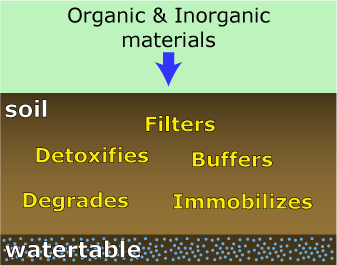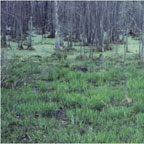Filtering and Buffering
Soil acts as a filter to protect the quality of water, air, and other resources. Toxic compounds or excess nutrients can be degraded or otherwise made unavailable to plants and animals.
 The filtering function of soil can be assessed by measuring or observing the following indicators:
The filtering function of soil can be assessed by measuring or observing the following indicators:
Toxicity Indicators including arsenic, copper, pesticides, and zinc
Organic Matter Indicators including C:N ratio, decomposition, microbial biomass carbon, particulate organic matter, soil organic matter, total organic carbon, and total organic matter
Soil Reaction Indicators including soil pHSalinity and Sodicity Indicators including electrical conductivity, exchangeable sodium percentage, sodium, and sodium adsorption ratio
Biological Activity and Diversity Indicators including active fungi, earthworms, potentially mineralizable nitrogen, respiration, soil enzymes, and diversity indices for organisms such as bacteria, macro and microarthropods, nematodes, and plants.
The minerals and microbes in soil are responsible for filtering, buffering, degrading, immobilizing, and detoxifying organic and inorganic materials, including industrial and municipal by-products and atmospheric deposits. Soil absorbs contaminants from both water and air. Some of these compounds are degraded by microorganisms in the soil. Others are held safely in place in the soil, preventing contamination of air and water. When the soil system is overloaded, such as with the excess application of fertilizer or manure, or when the soil is unstable, some contaminants will be released back to the  air and water through erosion or leaching.
air and water through erosion or leaching.
Wetlands function as nature's filters. Many human-made wetlands are created for this purpose. What happens to water that flows over pavement or through drain tiles?
